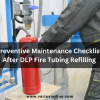![]()
Fire Immuniser
+91-7829629111
Email: info@variex.in
Varistor Technologies Pvt. Ltd.
Block-1, First Floor, Ardente Office One, Hoodi Circle, ITPL Main Road, Bengaluru, Karnataka 560048, IN
How Many Times Can We Use a Fire Extinguisher After Refilling?
Introduction
Fire extinguishers are one of the most effective tools in preventing small fires from turning into disasters. They are designed to quickly and efficiently extinguish flames, providing a crucial first line of defense in case of an emergency. However, like any other safety equipment, fire extinguishers require regular maintenance and refilling to ensure they remain functional. One often-asked question is how many times a fire extinguisher can be refilled before it becomes ineffective. In this article, we will explore this topic and discuss the factors that determine the lifespan of a fire extinguisher.
Understanding Fire Extinguisher Refilling
A fire extinguisher's primary purpose is to contain and extinguish fires by discharging an appropriate firefighting agent. Most fire extinguishers contain compressed gases, liquids, or powders that are expelled when the extinguisher is triggered, smothering the flames and preventing them from spreading.
When a fire extinguisher is used, its contents are depleted. After the discharge, the extinguisher needs to be refilled or recharged promptly to restore its firefighting capacity. Refilling involves removing the empty or partially used agent, inspecting and replacing any damaged parts, and refilling the extinguisher with the appropriate agent.
Factors Affecting Fire Extinguisher Lifespan
The number of times a fire extinguisher can be refilled depends on several factors:
1. Extinguisher Type: Different types of fire extinguishers have varying lifespans. Some extinguishers, such as those using carbon dioxide (CO2), have a longer lifespan and can be refilled more times compared to others.
2. Build Quality: The build quality of the fire extinguisher plays a crucial role in its longevity. A well-built and durable extinguisher can withstand multiple refills, while a poorly constructed one may suffer from damage or wear and tear, limiting its refillability.
3. Material Degradation: Over time, the materials used in a fire extinguisher can degrade, potentially compromising its effectiveness. This degradation can be accelerated by exposure to extreme temperatures, environmental factors, or improper storage conditions. Regular inspections and maintenance can help identify signs of material degradation.
4. Compliance with Standards: Fire extinguishers need to meet certain industry standards to ensure their reliability and effectiveness. Compliance with these standards is essential for maximizing the extinguisher's lifespan and refilling capabilities.
5. Maintenance: Regular maintenance, including visual inspections, pressure testing, and functional checks, is crucial for keeping a fire extinguisher in good working condition. Proper maintenance helps detect any issues early on, extending the lifespan of the extinguisher and allowing for more refills.
When to Retire a Fire Extinguisher
While fire extinguishers can be refilled multiple times, there comes a point when they should be retired and replaced. Here are a few signs that indicate a fire extinguisher has reached the end of its usable life:
1. Excessive Damage: If a fire extinguisher has been subjected to severe physical damage or has been involved in a significant incident, it may be unsafe to refill or use again. Such damage can compromise its structural integrity and decrease its effectiveness.
2. Corrosion: Corrosion is a common occurrence in metallic components of fire extinguishers. If corrosion is extensive and affects critical parts like the valve assembly or cylinder, the extinguisher should be retired.
3. Failed Pressure Tests: Periodic pressure tests are conducted to ensure that a fire extinguisher is capable of maintaining the required pressure for effective discharge. If an extinguisher fails these tests, it cannot be refilled and should be replaced.
4. Age: Fire extinguishers have a limited lifespan, typically ranging between 5 to 15 years, depending on the type and manufacturer. Even with proper maintenance, they may lose effectiveness over time due to material degradation. It is recommended to retire fire extinguishers after reaching their expiration date.
Conclusion
Fire extinguishers play a crucial role in safeguarding lives and property by quickly suppressing fires. While they can be refilled multiple times, the lifespan of a fire extinguisher depends on various factors such as the extinguisher type, build quality, and compliance with industry standards. Regular maintenance, inspections, and proper storage are essential for prolonging their effectiveness. However, fire extinguishers should be retired when damaged, corroded, or no longer pass pressure tests. By understanding these factors, users can ensure the reliable and continuous operation of their fire extinguishers in case of emergencies. Remember, prevention is key, and having a fully functional fire extinguisher is a vital part of fire safety.
Final Say
We at VariEx.in or Variexonline.com have mastered the art of designing, installing, inspecting, and fixing automatic sprinkler systems with the help of our in-house team, which is capable of delivering the fire sprinkler services you need, whether large or small and at affordable cost.
To schedule a fire sprinkler installation, or you think our services could benefit your commercial property, contact us online or give us a call at, 7829629111
"WHAT YOU CAN READ NEXT"
 Read more +24 November 2023 in Fire Extinguisher
Read more +24 November 2023 in Fire ExtinguisherWhat types of fire extinguishers are available for different fire classes?
 Read more +11 July 2025 in Fire Suppression
Read more +11 July 2025 in Fire Suppression







